Schnellzugriff
- Direkt zur Sitemap
- Direkt zur Suche
- Direkt zur Startseite
- Direkt zu Zugang für Alle
- Direkt zur Navigation
- Direkt zum Inhalt
- Direkt zum Kontakt

 Monday, 22 January 2024
Monday, 22 January 2024  Monday, 22 January 2024
Monday, 22 January 2024  Monday, 22 January 2024
Monday, 22 January 2024 In the coming days and weeks, Wall Street will be monitoring company results closely. The «Magnificent Seven» are likely to attract particular attention as their shares have risen sharply in 2023.
 Monday, 15 January 2024
Monday, 15 January 2024 Bonus Certificate Nestlé, Novartis und Roche
 Tuesday, 9 January 2024
Tuesday, 9 January 2024 «ZKB Favourite Stocks 2024»: Building Exposure with Reverse Convertibles
 Wednesday, 27 December 2023
Wednesday, 27 December 2023 The research at Zürcher Kantonalbank has identified ten equity top picks for the new year. The tracker certificate on the «ZKB Favourite Stocks 2024» allows investors to participate in this selection.
 Monday, 18 December 2023
Monday, 18 December 2023 A few trading days remain until the end of the year. After the loss-making previous year, the Swiss Market Index is set to post a positive performance.
 Tuesday, 12 December 2023
Tuesday, 12 December 2023 The shares of Basel-based pharmaceutical group Roche remain a source of concern for investors this year. We think the outlook for 2024 is slightly better. However, the shares remain exposed to risk.
 Thursday, 7 December 2023
Thursday, 7 December 2023 In the past, European luxury goods companies were among the stock market favourites. This year has been different.
 Monday, 4 December 2023
Monday, 4 December 2023 US retailers had a strong start to the holiday shopping season. However, it is unclear whether the momentum will continue in the coming weeks.
| ZKB Reverse Convertible auf Novo Nordisk A/S 140250665 / CH1402506658 |
| ZKB Barrier Reverse Convertible mit bedingtem Coupon, 24.06.2027 on worst of NVO UN/ROG SE/TEVA UN 144651781 / CH1446517810 |
| ZKB Barrier Reverse Convertible auf Novo Nordisk A/S 144652645 / CH1446526456 |
| ZKB Autocallable Barrier Reverse Convertible on worst of BASF SE/Novo Nordisk A/S/Vale SA 144652631 / CH1446526316 |
| ZKB Callable Barrier Reverse Convertible on worst of ASML Holding NV/Moët Hennessy Louis Vuitton SE/... 142530512 / CH1425305120 |
